Tag archives: condensed matter
The May 2017 issue of Physics World is now out
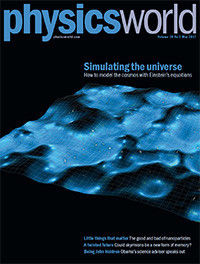 By Matin Durrani
By Matin Durrani
Einstein’s equations of general relativity might fit on a physicist’s coffee mug, but solving them is no mean feat. Now, however, the equations have been solved in a cosmological setting for the first time, as Tom Giblin, James Mertens and Glenn Starkman explain in the May 2017 issue of Physics World magazine, which is now live in the Physics World app for mobile and desktop
Elsewhere in the issue, you can enjoy an interview with John Holdren, who spent eight years as Barack Obama’s presidential science adviser. Find out too about the good and bad of nanoparticles and explore the potential that skyrmions – magnetic quasiparticles – could hold as a new form of memory storage.
Don’t miss either this month’s Lateral Thoughts, in which physicist Roger Todd describes how his invention of a system for automatically watering his house plants almost led to a commercial device.
Remember that if you are a member of the Institute of Physics, you can read Physics World magazine every month via our digital apps for iOS, Android and Web browsers.
View all posts by this author | View this author's profile
Snooker cues, negative mass, apps for waiting and CERN croissants
By Sarah Tesh
With the World Snooker Championship taking place at the moment, it’s that time of year when those of us who are usually snookered by the game are suddenly in its pockets. Right on cue, Phil Sutton from Loughborough University in the UK helps bridge the gap between science and snooker. In his video big break, he looks at why players use chalk on their cue tips. Interestingly, there is a right way to help you spin out a 147 and a wrong way that could leave you pocketing the white.
View all posts by this author | View this author's profile
Invisible robots overshadowed by metallic hydrogen
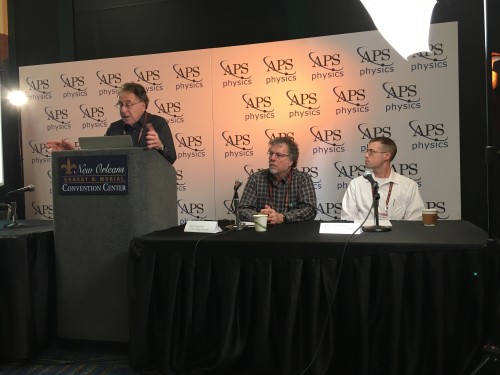
Metallic debate: Silvera, Ceperley and McMahon discuss metallic hydrogen. (Courtesy: Sarah Tesh)
By Sarah Tesh in New Orleans, Louisiana, US
After much coffee and a lot of crispy bacon, the second day of the APS March Meeting began. The hot topic of the day – metallic hydrogen. Even though we arrived 15 minutes early to Isaac Silvera‘s talk, the crowd was overflowing from the room, but despite all the pushing and shoving (my foot has not recovered from being stood on), we did manage to get seats. Silvera began by saying that he had been working on the problem for “probably longer than [most of us] were born” before taking us through the nearly 45 years of research on the subject. He also gave a press conference that included talks by theoretical physicists David Ceperley from the University of Illinois and Jeffrey McMahon from Washington State University. My colleague Tushna Commissariat caught up with Silvera later on, so be on the lookout for a more detailed update from her.
View all posts by this author | View this author's profile
Physicists take over the Big Easy

New Orleans: city with a view. (Courtesy: Tushna Commissariat)
By Sarah Tesh and Tushna Commissariat in New Orleans, Louisiana, US
It is that time of the year again when around 10,000 physicists gather for the American Physical Society (APS) March Meeting and this year we’re in the Big Easy. While yesterday was a jetlag-recovery day, it’s all kicking off today at the sprawling Ernest Morial Convention Center, where more than 9600 papers will be presented during the week.
Despite our sleep-deprived state yesterday, we played the traditional game of “spot the physicist” during our wanderings in the French Quarter. This was made particularly interesting with the simultaneous game of “spot the spring-breakers”. Relaxed, youthful students chatting loudly about their late-night escapades were a stark contrast to academics looking anxious and lost while over-burdened with poster tubes, suitcases and laptop bags.
View all posts by this author | View this author's profile
A laser-bubble mermaid, ode to seven exoplanets, metallic hydrogen is lost
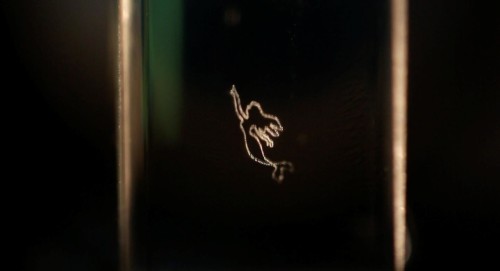
Tiny bubbles: a laser-made mermaid. (Courtesy: Kota Kumagai/ Utsunomiya University)
By Hamish Johnston
A popular way of melding science and art is to create an image of a mythical being in your lab. Yoshio Hayasaki and colleagues at Utsunomiya University in Japan have made a pretty good likeness of a mermaid using a laser that forms tiny bubbles inside a liquid. “In our display, the microbubble voxels are three-dimensionally generated in a liquid using focused femtosecond laser pulses,” explains team member Kota Kumagai.
View all posts by this author | View this author's profile
Probing the quantum nature of water
By James Dacey in Beijing on Friday 4 November
After enjoying clear blue skies for the first couple of days of my visit to Beijing, the breeze has disappeared and the smog has taken its hold. One local scientist told me this latest wave is due to pollution from factories south-west of the city, but others have told me it is difficult to pinpoint a particular source. Facemasks are being worn by every other person in the streets, but fortunately I’ve been sheltered by the walls and ceilings of Peking University (PKU).
View all posts by this author | View this author's profile
A great day out at the Institute of Physics in Beijing
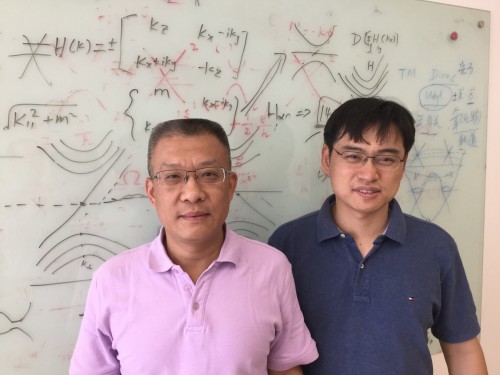
Weyl theorists: Zhong Fang (left) and Hongming Weng.
By Hamish Johnston in Beijing
This morning I had a wonderful visit to see some condensed-matter physicists at the Institute of Physics of the Chinese Academy of Sciences (IOP CAS). First I met with theorists Zhong Fang and Hongming Weng and if you know your equations you can see from the above photo that they work on Weyl semi-metals. Fang is deputy director of the institute and is head of a theoretical physics group that includes six faculty members and about 20 postgraduate students. Avid readers might recall that Fang and Weng were named in the Physics World Top 10 Breakthroughs of 2015 for their work on Weyl fermions.
View all posts by this author | View this author's profile
Chatting about Chinese computing
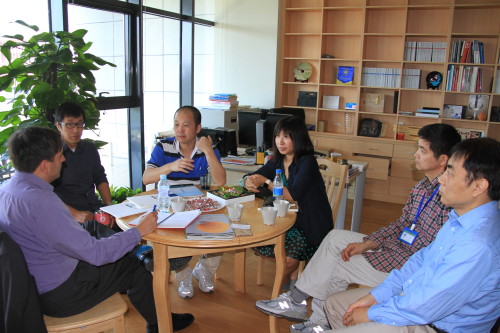
Calculated efforts: Matin Durrani (far left) in conversation with staff at the Beijing Computational Science Research Center, including Hai-Qing Lin (third left). (Courtesy: Mingfang Lu)
By Matin Durrani in Beijing, China
The last couple of days in the Chinese capital have been unusually damp and cool for the middle of June. Today, however, dawned sparklingly sunny as I headed off with my colleague Mingfang Lu from the Beijing office of the Institute of Physics, which publishes Physics World, to the Beijing Computational Science Research Center (CSRC) on the outskirts of the city.
Located on a shiny new software park, this sleek, five-storey building opened in March last year and looks just how you might expect the headquarters of IKEA to be – all minimalist corridors, big glass windows and the odd work of art dotted around. There’s even a fitness room in the basement. It’s currently got 43 full-time faculty, a third of whom are physicists, making this 45,000 m2 building – roughly the size of seven football pitches – seem remarkably sparse.
View all posts by this author | View this author's profile
China’s Silicon Valley
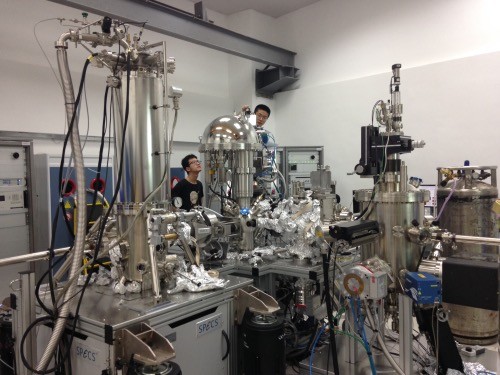
Researchers working on an angle-resolved photoemission spectrometer at the South University of Science and Technology of China.
By Michael Banks in Shenzhen, Guangdong province, China
It is well documented how China seems to be able to build cities within weeks. But how quickly could it build its very own Silicon Valley?
Well, that question may well be answered very soon. Today, I was at the South University of Science and Technology of China (SUSTC), which is located in Shenzhen, Guangdong province.
The university was only created in 2011 and currently the physics department has a sole focus on experimental and theoretical condensed-matter physics, with around 20 undergraduate students each year (that number is expected to rise as the department expands into other areas of physics).
View all posts by this author | View this author's profile
Would you encourage your grandchildren into condensed-matter physics?
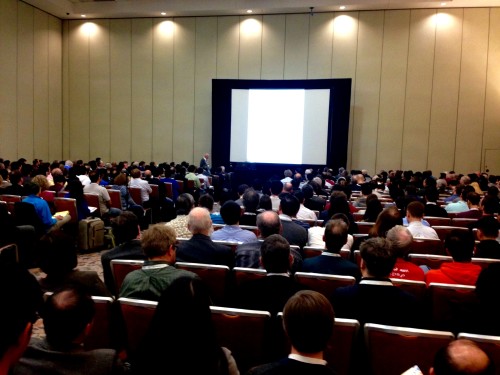
Packed in: a full room for Anthony Leggett’s talk. (Courtesy: Tushna Commissariat)
By Tushna Commissariat in Baltimore, Maryland, US
One of the most popular talks this morning at the APS March meeting was almost certainly given by Nobel-prize-winning physicist Anthony Leggett of the University of Illinois at Urbana-Champaign in the US. Leggett, who shared the 2003 Nobel Prize for Physics for his work on superconductors and superfluids, talked about his “Reflections on the past present and future of of condensed-matter physics”.
As the abstract of his talk suggests, Leggett looked at the ways, means and even the very definition of “condensed-matter physics” has changed and “evolved since its inception in the early 20th century, with particular reference to its relationship to neighbouring and even distant disciplines”. He went on to “speculate on some possible directions in which the discipline may develop over the next few decades, emphasizing that there are still some very basic questions to which we currently have no satisfactory answers”.
I missed the beginning of his talk as I was attending the morning’s first set of press briefings (more on those later) but when I did walk into the packed hall for his talk, his slide had the rather interesting title: “Would I encourage my grandchildren to go into condensed-matter physics?” Happlily enough, his answer at the end of his talk was a resounding “yes”.